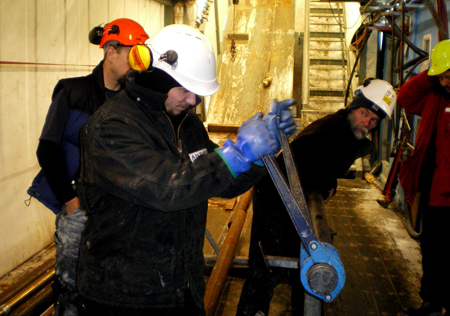|
New field season offers different challenges as scientists race against time on the sea ice
Return of ANDRILLThis season, the coring project is on much thinner sea ice – about 8 meters thick – buoyed underneath by a second layer of ice called frazil ice, fine plates of ice suspended in water.The project originally planned to use divers to deploy floats under the ice to support the drilling platform. But the multi-year sea ice, buoyed by the frazil ice, appears to be in good shape, according to Harwood. “Alex Pyne, ANDRILL’s drilling science nanager, from Victoria University of Wellington, is pretty confident that we’ve got a good floating platform,” Harwood said, adding that the operation is about 8 kilometers from the boundary between thick multi-year ice and annual ice that blows out of McMurdo Sound each summer. “So we have a pretty good buffer with that as well.” Despite the strong platform, time is still of the essence. As the summer sun heats up, it will create melt pools and soften the ice upon which the drilling rig and camp will have to traverse to return to McMurdo Station and Scott Base. Harwood said the last core should come up at the end of November or early December. Researchers will then deploy several instruments down the borehole to map geophysical properties, including a televiewer, a special camera that uses sound waves to produce an image of the borehole wall. The whole operation should move off the sea ice by Dec. 15, about the same time when the Annual Sea Ice Runway moves to the ice shelf. The change in location from last year also means a change in logistics, with the rig located about twice as far from McMurdo Station and New Zealand’s Scott Base. That means about 30 members of the drill site team live at the work site, in a camp only about 500 meters from the rig. Several scientists will also work and live at the isolated camp for the duration of drilling operations. Their job is to make the initial analyses and measurements only minutes after the three-meter-long cores come out of the ground. Helicopters then transport the cores to McMurdo for further study. The five-minute walk to work suits Cristina Millan, a member of the core description team at the site. “The camp is great,” she wrote in her online blog. “Quite a set-up, overall, when I think of how most people do research here, and what a logistical nightmare living and working in Antarctica is.” The science goals are also a little different this year. While not drilling as deeply as last year, the science team is after a geological record of sedimentation stretching back 17 million years. A key target date is the middle Miocene, a time between 14 million and 15 million years ago, when the Earth was much warmer than today, and for an extended period. The two ANDRILL drill cores, along with those recovered from coastal drill sites in the 1970s and 1980s, will provide a broader context for interpreting the area’s geologic history thanks to overlapping time intervals. “By seeing the same event from these different locations, you can better understand its complexity, and provide a geographic, spatial context to the environmental changes evident in the cores,” Harwood said.
Primed for rerunsThe ANDRILL project has ambitions for casting an even wider net over the area’s geological history, with three proposals for new drill sites in various stages of completion.In fact, a small team of researchers led by Ross Powell and Marv Speece will explore a site known as the Mackay Sea Valley, northeast of Cape Roberts in the Ross Sea, this season, according to Harwood. The objective there isn’t millions of years, but thousands of years. Researchers believe the area holds very young sediment, back to the beginning of the Holocene period, just 11,000 years ago. Such a short period would allow scientists to look at the transition into the modern interglacial period, following the last glaciation, with a high level of detail. Harwood said the program would submit a proposal for yet another site, Coulman High east of Ross Island, next June. That site swings to the other extreme, the early Miocene and even further back, perhaps 50 million years. While not drilling next year, ANDRILL scientists will collect survey data in the Offshore New Harbor area, looking for an additional future drill sites in that region. “ANDRILL is a project where we’re trying to understand climate history under many different time scales,” Harwood said. “ANDRILL has different science questions, and these projects are geared towards answering those different questions by attacking different parts.” However, those projects are not yet funded. Wagner said he looks forward to reviewing the new proposals as they develop. “The international community and the U.S. community are really gung-ho on a number of ANDRILL projects, and I fully expect to see proposals in from them,” he said. For Harwood and the other 60 scientists and support staff working this season, the focus now is on the frenzied weeks of work ahead. “We’re all very eager and very anxious for the next core, and just keen to see what mysteries are about to be revealed as we continue further back in time to a period in Antarctic history that has not adequately been sampled,” Harwood said. “We’re on the edge of discovery.” NSF-funded research in this story: David Harwood, University of Nebraska-Lincoln. |



For USAP Participants |
For The Public |
For Researchers and EducatorsContact UsU.S. National Science FoundationOffice of Polar Programs Geosciences Directorate 2415 Eisenhower Avenue, Suite W7100 Alexandria, VA 22314 Sign up for the NSF Office of Polar Programs newsletter and events. Feedback Form |


.jpg)
